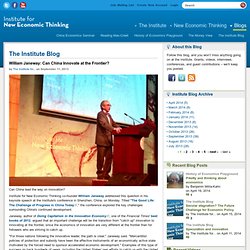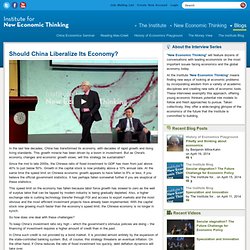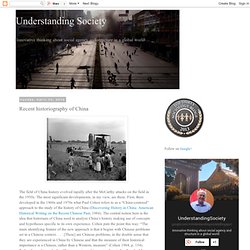

William Janeway: Can China Innovate at the Frontier? Can China lead the way on innovation?

Institute for New Economic Thinking co-founder William Janeway addressed this question in his keynote speech at the Institute's conference in Shenzhen, China, on Monday. Titled "The Good Life: The Challenge of Progress in China Today," the conference explored the key challenges surrounding China's continued development. Janeway, author of Doing Capitalism in the Innovation Economy, one of the Financial Times' best books of 2012, argued that an important challenge will be the transition from "catch up" innovation to innovating at the frontier, since the economics of innovation are very different at the frontier than for followers who are striving to catch up. "For those nations following the innovative leader, the path is clear," Janeway said. "Mercantilist policies of protection and subsidy have been the effective instruments of an economically active state motivated by the forced need to sponsor accelerated economic development.
" Should China Liberalize Its Economy? In the last few decades, China has transformed its economy, with decades of rapid growth and rising living standards.

This growth miracle has been driven by a boom in investment. But as China's economy changes and economic growth slows, will this strategy be sustainable? Since the mid to late 2000s, the Chinese ratio of fixed investment to GDP has risen from just above 40% to just below 50%. Growth in the capital stock is now probably above a 10% annual rate. At the same time the speed limit on Chinese economic growth appears to have fallen to 8% or less, if you believe the official government statistics. This speed limit on the economy has fallen because labor force growth has slowed to zero as the well of surplus labor that can be tapped by modern industry is being gradually depleted. So how does one deal with these challenges? In China such credit is not provided by a bond market. Managing Financial Instability in China. In Macroeconomics 101, you are taught about how the banking system in modern economies works.

But as Institute for New Economic Thinking Senior Fellow Adair Turner notes in this presentation from the Institute’s recent conference in Shenzhen, China, the textbooks bear little relationship to the realities – in particular, the role that finance plays in our modern system. And then there are the specific problems which the Chinese authorities face: Their system is rife with debt. There are four causes of debt excess. They are separate but tend to be related. In countries that develop debt excesses more than one is operative, but usually not all four. But while this might be a potential boon for domestic savers, liberalization creates its own challenges, given the high prevailing levels of debt in the Chinese economy today.
So what will the Chinese choose to do and what will be the outcome of their policy choices? Adair Turner suggests a few options.
On the quality of data... The Chinese Transition in Global Perspective. Chinese Finance and Economic Internationalisation. China's Economy & economic development. Can Chinese growth be sustained? The Chinese economy in 2013. Chinese Politics... China in world politics. Debating population in China. Inequality in China: trends & local issues. Spatial / regional inequality in China. Recent historiography of China. The field of China history evolved rapidly after the McCarthy attacks on the field in the 1950s.

The most significant developments, in my view, are these. First, there developed in the 1960s and 1970s what Paul Cohen refers to as a “China-centered” approach to the study of the history of China (Discovering History in China: American Historical Writing on the Recent Chinese Past ; 1984). The central notion here is the idea that historians of China need to analyze China’s history making use of concepts and hypotheses specific to its own experience.
Cohen puts the point this way: “The main identifying feature of the new approach is that it begins with Chinese problems set in a Chinese context. . . . Second, there has emerged a substantial emphasis on material culture in the China field: social and economic circumstances, the technology of agriculture, marketing hierarchies, and the circumstances of life of ordinary Chinese people. Is a good example of this kind of detailed local study.
China - reading... China - Curators. To sort... Under construction...